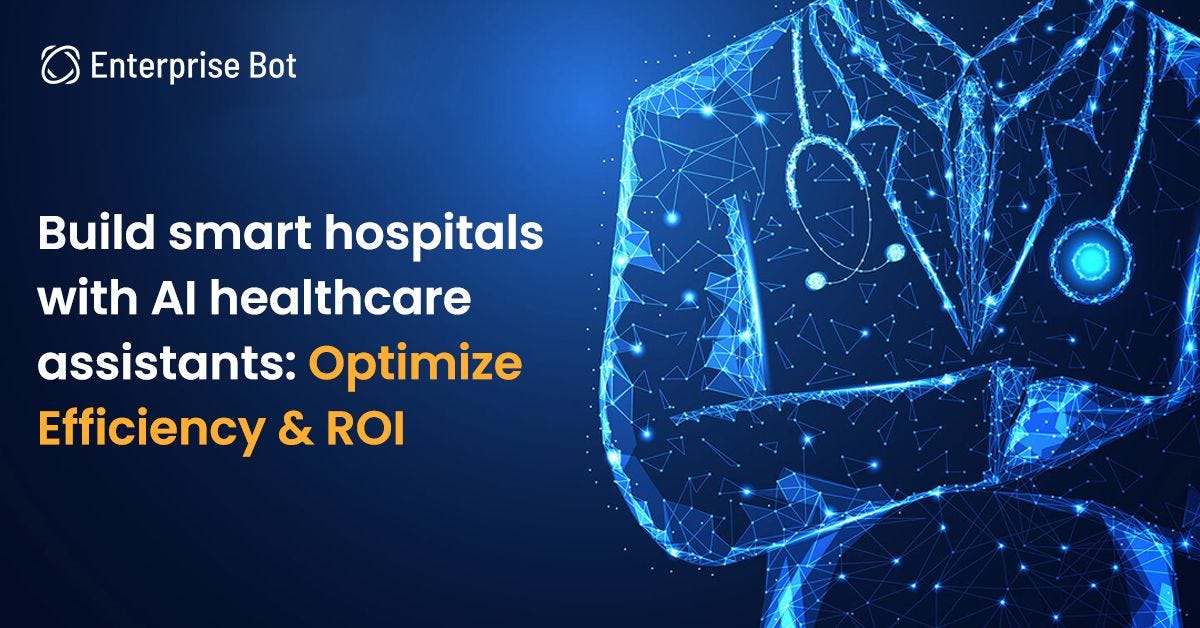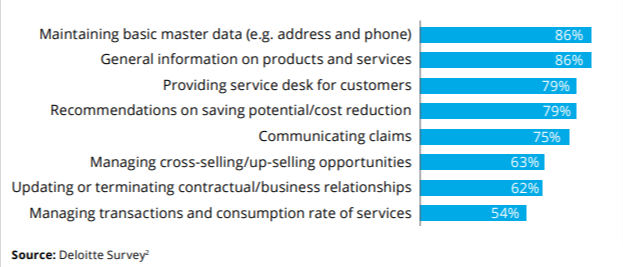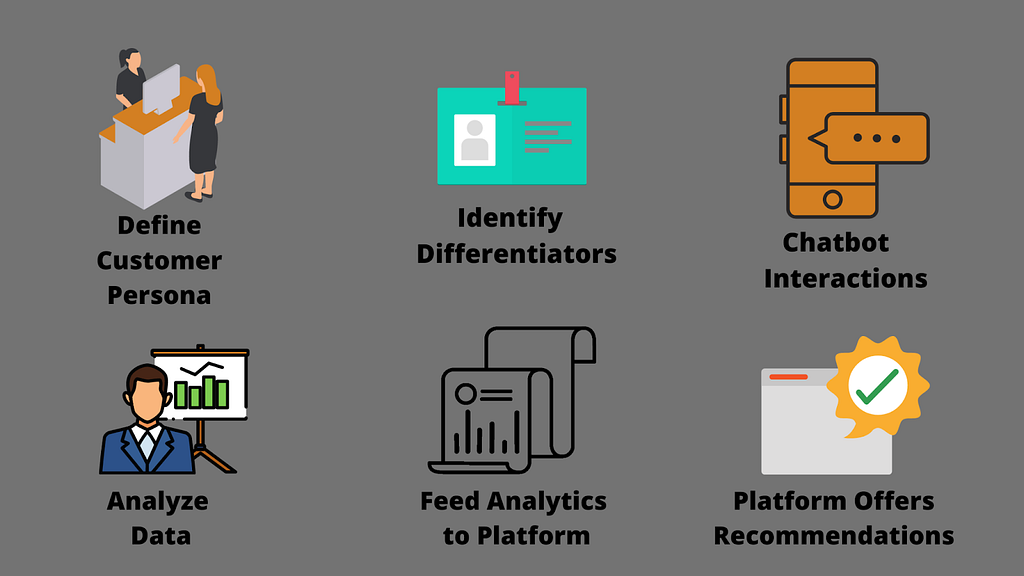 |
Hey, I recently made a notebook tutorial on training a Rick & Morty chatbot but feedback suggested it was too long and complicated. So here is a much simpler version! It lets you deploy any pretrained chatbot on huggingface really easily. You’ll be able to chat with it through a mobile app, just like in the picture below. The notebook can be found here Hopefully someone finds it helpful submitted by /u/rsedlr |
Month: August 2021
-
Deploying a pretrained chatbot on Chai
-
Building a Chatbot for Your Business: Statistics to Watch Out in 2021 and Beyond
Chatbots have gained traction in the business industry in a short span. We can see every other online business investing in Chatbots to improve their customers’ engagement and customer services.
Some of the most popular AI-enabled voice assistants and Chatbots are Google Home, Apple Siri, Microsoft Cortana, and Amazon Alexa. They have transformed the way customers do online searches. The best thing is you can implement Chatbots to your website, messaging app, or social media channel and offer your customers human-like conversation round-the-clock.
Before hiring a Chatbot development company for your business, let us look at some trending statistics about chatbots in 2021.
- According to Outgrow, every 3 in 5 millennials have used Chatbots for online search at least once.
- Gartner says that voice will account for 25% of customer interactions by 2023.
- Currently, we have more than 300,000 active bots across the globe, as per the review42.
- Businesses that use Chatbots for automating conversations are likely to meet their customers’ needs and demands better by 27%.
- As per the research by TechCrunch, we can expect $40 billion+ through voice shopping in the USA and UK.
- The industry that will make more profits using Chatbot technology is retail. It means 70% of Chatbots will be retail-based by 2023.
- According to HospitalityTech, travel Chatbots can help us save both time and money. Thus, we can expect 84% users taking advantage of this innovation.
Based on the above discussion, we can say that Chatbots have a bright future in every sector and industry. It is still booming. If you adopt this technology to your business early, you can gain an edge over your competitors and increase your revenue by 30%. So, hire a Chatbot developer today to begin your journey towards a voice-enabled world.
submitted by /u/sp_jamesdaniel
[link] [comments] -
Learn how to personalize your Chatbots on Websites
The process doesn’t stop when you get a chatbot for the website. You need to train it rigorously and make it more personalized so that it creates an engaging experience for your audience. There are many benefits of personalizing chatbots on websites. From customer acquisition to engagement, the list of advantages is limitless.
Here are some of the tips for personalizing your Chatbots on Websites:
- Understand your website visitors
- Use visual elements within the chat
- Give language options for making conversation to your audience
- Develop relevantly conversation recipes
- Regularly analyze the insights and reoptimize the flows
When you can address the above tips, nothing can be more personalized than this. These are some of the major qualities that are required in chatbot for website. Let me know if there are any additional tips that help.
submitted by /u/Content-Decision-737
[link] [comments] -
Understand how Rasa Framework works

rasa framework. Rasa is a python framework that helps us to build any kind of Chatbot easily. It based on NLU (Natural Language Processing) which offer the possibility to understand what the user want. Let’s discover it.
Firstly you must know how the Chatbot works. The Chatbot is a conversational agent which talk with a client or user and provide answers to the users’ requests independantly of the human intervention.
The Chatbot is composed by some specifics terms that we will discover:
Intents: It represent intentions that the user want to express when he submit his message to the Chatbot. Inside the intents, we provides somes phrases that the user may ask and we also provide some responses that the Chatbot must use to answer to the user. It’s the work of the Developper here.

Entities: Entities are keywords that represent some specifics datas that the Chatbot may use to perform the discussion with the user. Entities are used to extract some values inside the user input (message).
Now, we know how Chatbot works, we can switch to the Rasa Framework.
Rasa is split into two python librairies like Rasa NLU and Rasa Core. The first one is the Natural Language Understanding and use the intents to understand what the user want and entities to extract some specifics values to make the conversation more interesting, after Rasa NLU have understood what the user want and extracted somes values, it send it to the next one. Rasa Core receives the data sended by Rasa NLU and process it to find the correct answer that it should send to the user as output, For having a response, it will look for the responses that the Developper provided to him inside the intents.
Trending Bot Articles:
2. Automated vs Live Chats: What will the Future of Customer Service Look Like?
4. Chatbot Vs. Intelligent Virtual Assistant — What’s the difference & Why Care?

Functioning of Rasa Explanation:
- The User submit the request (a message is sended to the Interpreter)
- In the Interpreter section, we have Rasa NLU which capture the request, and extract intents to understand what the user want, and in the same time it extract some specifics keywords (entities) which represent the important data. Then it send the result to the Tracker. The rest of the elements below is contained inside Rasa Core.
- The Tracker here, is used to store the conversation history in memory. By this fact, the Chatbot should know in where level the conversation is, it maintains the conversation state.
- After that, the Policy comes; it choose the action which will be execute at every step in the dialogue, regarding the history of the conversation.
- The Action here, look inside the history for consulting the state of the conversation. This step can trigge another action.
- The action is executed and an ouput is generated (message from the Chatbot) to the user.
Now you have a brief understanding on how Rasa Framework works, you can now decided to learn about how you can build your own chatbot using this framework.
just check out the documentation of Rasa.
for more explanation: https://rasa.com/docs/rasa/playground
Thank to you reading.
Don’t forget to give us your 👏 !



Understand how Rasa Framework works was originally published in Chatbots Life on Medium, where people are continuing the conversation by highlighting and responding to this story.
-
Build smart hospitals with AI healthcare assistants: Optimize Efficiency & ROI
Today, innovation is viewed as the main impetus behind enhancements in healthcare. When you take a gander at the pace of progress and…
-
10 Reasons No-Code AI Chatbot Is Going to Be Big in 2022
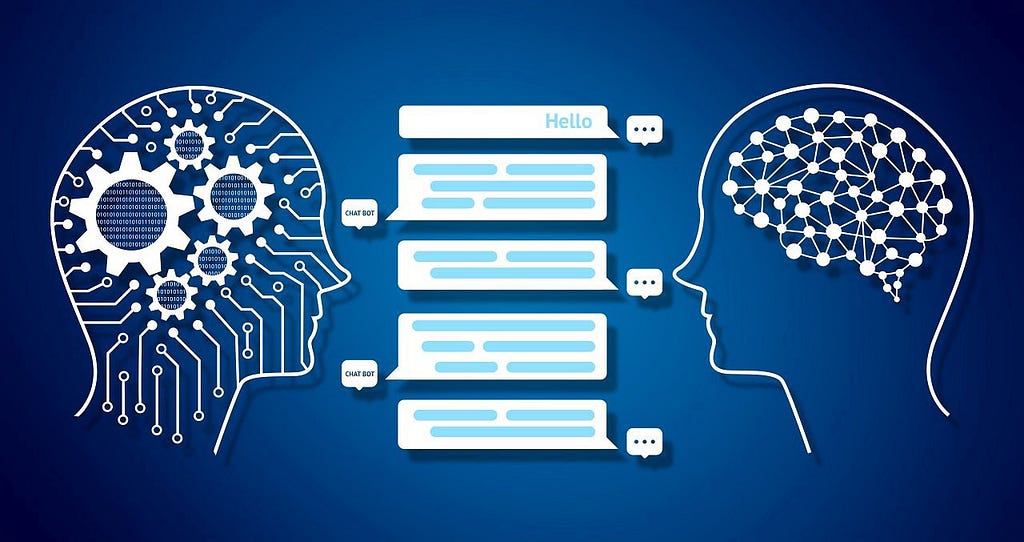
Source A conversational platform strategy not only entices customers but also ensures an effective solution for employees and partners. Everyone is aware that Chatbots use artificial intelligence to impersonate human conversations.
With time, the technology has updated, and it now offers advanced solutions with improved AI-enabled language capabilities. By the year 2022, more than 70% of skilled workers will interact on these platforms daily. AI Chatbots in business is the smartest way to interact with customers.
Companies today look at customer satisfaction as a crucial element in conversational AI technology that assumes importance in a skilled manner. As a result, chatbots are a viable adoption to AI, and more than 40% of millennials use chatbots to connect to different businesses.

But for startups, the implementation of conversational AI can be complex, so it’s better to start with the no-code AI technology. No code space chatbots platforms empower the sections to take innovation and software development into their own hands.
Today, the future of coding is no coding — that is the new buzz phrase in chatbot technology. When demand for software exceeds the coders, no code technology is adapting to software developer skill shortage. A Forrester report predicts that no code AI technology will grow from 3.8 billion in 2017 to 21.2 billion in 2022.
Google has also jumped on the wagon by acquiring the technology on its Google Cloud platform. It proves that the potential of no code works as a mainstream solution for software development and Chatbot technology.
Trending Bot Articles:
2. Automated vs Live Chats: What will the Future of Customer Service Look Like?
4. Chatbot Vs. Intelligent Virtual Assistant — What’s the difference & Why Care?
In this article, we will explore why your business software should take advantage of no-code Chatbot technology. By doing so, you will be able to make a feasible decision about whether to implement and integrate the technology.
What is No code AI Chatbot technology?
About 40% of companies state that AI Chatbot technology and expertise are expensive. No code AI solutions help make the technology accessible and available at a low cost. It aims at using a no-code development platform with code-free features, visual elements, and a drag & drop interface.
With the help of the features, you can deploy Machine Learning models with Artificial Intelligence. It allows non-technical users to classify the data and build accurate models that help make predictions in the process. The business adoption for no code Chatbot AI is implemented based on the demand.
Why should you use No-code AI for business?
Building AI models requires training and time. But no code AI reduces the time to build the AI models and enables companies to adopt and integrate with other technologies.
No-code AI solutions have not replaced the data science methods or the popular machine learning technology, but the popularity has increased with time. With the increase and flexibility in new solutions, widespread integration helps to adapt the technology.
No coding technology for chatbots needs to be adopted at a faster pace for good results. On the contrary, it reduces the entry barriers for startups and established companies. So let’s dive into the reasons why this technology is going to be big in 2022.
10 Reasons No-Code AI Chatbot Is Going to Be Big in 2022:
- Flexible to accommodate different industry demands
- Reduces complexity of IT operations
- Increased productivity
- Changeable codes
- Transition process is smooth
- Address the developer skills gap
- Better tactical alignment
- Improved business agility
- Strengthens customer support
- Increased security function
1. Flexible to accommodate different industry demands
No code platform features are easy to understand compared to the coding features in AI technology. They are flexible, making them practical to implement in any organization that wishes to incorporate chatbot technology.
For example, Chatbots integrated with insurance companies will increase the reach and adaptability. In addition, technology has the powerful ability to impact working and organization to increase the engagement level.
It helps the company to expand geographically and reach potential customers. From payment service providers to railway service operators, no code AI Chatbots empowers every sector at a low cost, which is an advantage.
2. Reduces complexity of IT operations
No code platform reduces the strain of IT development. You don’t need to create an app for multiple platforms, as you can make an app while regulating the governance. As a result, you can accelerate digital innovation and transformation by relying on no-code technology and reducing dependency on technical developers.
You can skip the hiring of expensive full-stack developers and escape the route from the debts. Companies can rely on their in-house IT team to do the job with no coding AI solutions. Reduction in complexity of developing a platform helps companies focus on other essential functions.
3. Increased productivity
The applications that are built on no-code technology don’t burden the IT team. They can make the apps at a faster pace without hesitation, without taking weeks or even months. Most IT teams work on the app in few hours, as there is no coding feature.
It helps increase employee productivity so they can work skillfully on other IT tasks. Compared to the traditional app-building ways, the no-code platform reduces the hand-coding of various languages and minimizes the risk involved. With the technology, you will witness increased IT output from your team.
4. Changeable codes
Developers who work with codes face a lot of issues while changing the code structure. The problem with traditional coding is; you can’t change the functionality or the feature within the code structure. It happens more if the language or the framework is new.
With no code AI technology, you won’t have this issue. You will be able to change codes or with different functions. If you need to change something, implement a new logic structure in the code and process it. You will have the change ready in minutes or a few hours. Changeable codes can save your coding efforts.
5. Transition process is smooth
The benefits of the no-code AI platform depend on the speed. Building a bot for email only takes a couple of different steps. First, it includes synchronization and integration of emails from the CRM platforms or Microsoft software.
Once you upload your emails with the labels in the no-code platform, AI will construct the machine learning (ML) structure and connect to Outlook or other platforms via the exchange services. Once your step is complete, the email assistance will be ready to accept the correspondence. You can enhance the bot feature to boost the automation feature at a later stage.
6. Address the developer skills gap
Complex technology is being distilled into simple structures, which is bridging the gap between development and result. With a no-code platform, you don’t need to hire the best software developer in the company.
More prominent companies are taking advantage of the platform by targeting the implementation in IT operations alongside the basic features. The software can help you converse with your customers without spending elusive money on development tasks. No code AI development market is expanding rapidly, and by 2022, most companies will implement the technology.
7. Better tactical alignment
The technology provides a closer alignment between different Chatbot outputs and business requirements. All the traditional needs get lost between communication and technology. Chatbot developments without the need for coding enable cross-functional participation.
It ensures that the end product aligns with the client’s expectations. Business users with deep domain proficiency can define different bots without explaining the ideas to customers or others. The tactical alignment results in a better outcome that enables a better technical foundation for the company.
8. Improved business agility
Using the no-code AI technology, you can develop chatbots faster than using the traditional coding structure. The conventional methods require the coding to be done from scratch, but within no-code spaces, almost all building blocks are available at the same place. As a result, the focus can go on the chat features than on time-consuming core functions.
Your IT team will not focus on the basic features; they can rely on the advantage of a ready structure that helps in the smooth functioning of the app. It guarantees complete compliance without focusing on multiple levels. Furthermore, with this platform, you can monitor all the modifications you make to the app.
9. Strengthens customer support
Scalable Chatbot platforms across multiple channels understand different languages and engage with potential customers in a human-like manner. No-code platforms are accessible, and professionals and Non-IT professionals can work on the platform to increase customer retention. Customer retention improved by a mere 5% can raise profits considerably.
As customer demand is ever-evolving, the chabot feature strengthens the customer support function. It offers a smoother and more credible experience for clients and people who show interest in products. In addition, the smart solutions enable 24/7 customer care features.
10. Increased security function
Another reason — you must deploy no code Chatbot is security. With the latest updates and enhancements in IT developments, the threats are getting severe. Most websites and applications are vulnerable to security threats, which cause loss of data.
Poorly coded chatbot features can make the business vulnerable to different hacks and attacks. Codes developed in isolation or with specific structures can leave businesses more susceptible. Platforms and companies that adopt Chatbots without coding ensure proper security as there is no threat to structure.
Final recap,
Customer engagement is hard to achieve. A chatbot is an essential tool for business communication and customer support. Chatbots are complex to build, as the developer has to use ML and AI algorithms with the data to create Chatbots and apps. Any mistake in the structure or code can have a catastrophic effect on the app solution.
No code AI Chatbot platform can provide accurate implementation without building a bot from the start. More than 57% of companies use no-code chatbot platforms for business, and the numbers will scale higher in the coming years. The trend is going upwards, and it is time you reap the benefits of the technology for your business.
Don’t forget to give us your 👏 !



10 Reasons No-Code AI Chatbot Is Going to Be Big in 2022 was originally published in Chatbots Life on Medium, where people are continuing the conversation by highlighting and responding to this story.
-
Making a Rick & Morty chat bot for Chai

Hey, I made a notebook tutorial to try and make it as simple as possible to train and deploy a DialoGPT bot. It uses dialogue from Rick and Morty to train a Rick bot and then deploys the bot onto Chai, a platform for creating and interacting with conversational AI’s.
By the end of this tutorial you will have your very own chatbot, like the one pictured 😎
The notebook can be found here
Thanks!
submitted by /u/rsedlr
[link] [comments] -
How to Leverage Chatbots for Lead Nurturing and Conversions?
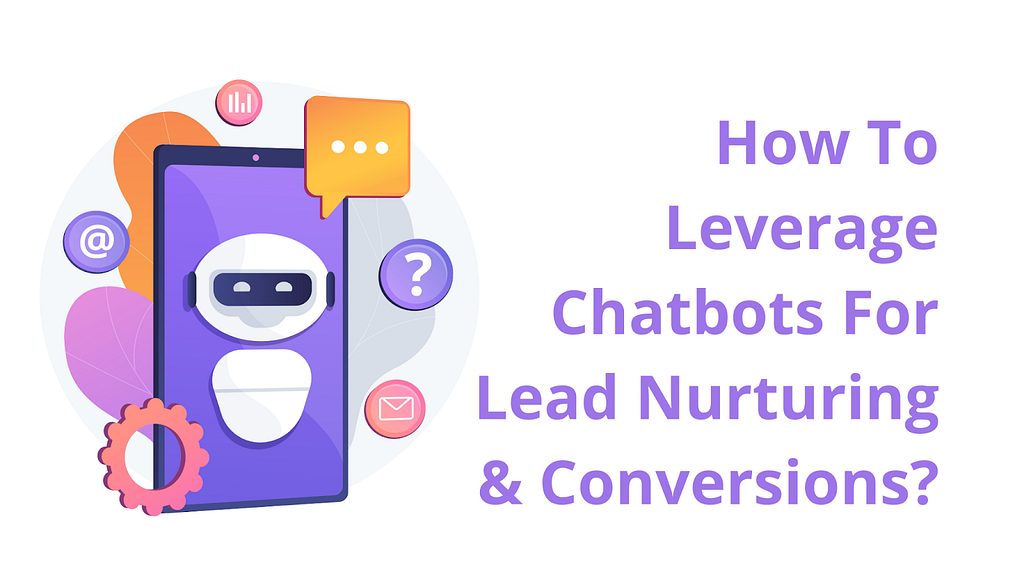
What is the most challenging aspect of marketing? Its conversions, correct? Identifying your potential customer, predicting their interest, engaging, and nurturing them for an ultimate buyout is not that easy.
This is where Artificial Intelligence can help you analyze the customer pool, identify and segregate lead. Further, you can even nurture them using AI-based algorithms, which helps in delivering high value.
Take an example of the famous inbound marketing giant Hubspot. It has leveraged chatbots to improve qualified lead generation by 182% and increase in-chat engagement by 75%. So, Ai-based chatbots are the new age wizards for your marketing needs. First, however, you need to know how and when to leverage a chatbot for lead nurturing and conversions.
Here, we will discuss both starting with how!

Top Ways to Leverage Chatbots for Lead Nurturing
Chatbots can power your customer support, enhance customer journeys, and even help you nurture leads. It uses technologies like Artificial Intelligence, Natural Language Programming, and Speech Recognition. As a result, chatbots have become a beacon of AI-based marketing, where data aggregation, analysis, interactions, and smart product recommendations are seamless.
AI-based marketing can help you in conversational excellence. When it comes to conversation-based marketing, it has three pillars,
- Listen to your customer
- Deliver personalize experience
- Engage, engage, engage
Let’s discover how chatbots merge conversational excellence with intelligent AI algorithms to nurture leads!
Trending Bot Articles:
2. Automated vs Live Chats: What will the Future of Customer Service Look Like?
4. Chatbot Vs. Intelligent Virtual Assistant — What’s the difference & Why Care?
#1. Customer Segmentation
Nurturing your leads needs segmentation of customers. It will help you to personalize the content as per the segment of the customer. However, segmentation needs data aggregation and analysis to create buyer patterns.
Chatbots can do both easily by extracting data through conversations with users and analyzing them through the backend algorithms. The process starts with data aggregation from users, which is a crucial aspect of chatbot conversations. A Delloite survey suggests that most of the chatbots used to carry out the function of maintaining master data(especially addresses and phone numbers)
Moreover, these chatbots can also enable customer segmentation based on demography, psychography, geography, and behavioral changes. Interactions of users with your business largely depend on the behavioral data. So, it is essential to design the entire segmentation process for optimized data accumulation.
Here is a process that you can follow,
- Step-1- Define target personas
- Step-2- Identify the differentiator
- Step-3- Chatbot interactions that aggregate data per differentiator
- Step-4- Analyze the customer data collected from the chatbot interactions
- Step-5- Input data patterns into the marketing platform
- Step-6- The platform uses differentiators and patterns to offer recommendations
Define Customer Persona — Blog Banner (canva.com)
Customer segmentation is the first process towards the identification of leads which you can nurture through a chatbot.
#2. Lead Identification
Every interaction from a customer with your business does not qualify for a lead, and that is where a chatbot can come in handy. However, identifying a lead from several interactions is not that easy, and chatbots can leverage AI-based technologies to identify specific patterns to segregate leads.
For example, if you are looking to find leads for your roofing business, you need to segregate between leads which can be a person(B2C) or a company(B2B) with an interest in your product or services. These leads can be marketing qualified or sales qualified, but identifying them is key to figuring out the conversations with each lead to nurture them.
Now that you have qualified leads and segmented leads executed, the next step will be to personalize further conversions for specific data aggregations.
#3. Customized Data Aggregations(Forms vs. Bots)
One of the most conventional approaches that most organizations used for data aggregation was forms. To target them with specific promotional campaigns, customers will fill details in the form that marketing teams can leverage for lead identification and segregation.
However, it is not an efficient way of gathering data, plus filling forms is a tedious job for customers. Here, a chatbot can help you aggregate data without the hassle of a form. Apart from the engagement, another essential fact is the amount of data that chatbots can extract for you.
Forms have limitations of fields that chatbots don’t have, and most importantly, these bots can interact with a user than just asking to fill a form. For example, the average conversion rate of the lead generation form on the landing page is 2.35%. A chatbot, on the other hand, offers 10%-100% conversion rates.
So, a chatbot can help you gather data for lead generation and gather crucial information to nurture the lead up to the point of sale. Though your ultimate goal may be to reach the sales part, it never ends there. You will need a reliable customer support system to enhance the customer journey and keep them returning to your products or services.
But, the question that will come to your mind will be; are chatbots enough?
#4. Hybrid Customer Support
Customer support systems are great to help your customers, but they lack efficacy. According to Statista, 27% of American customers are frustrated due to ineffective customer service. The same report suggests that 12% of American customers point out lack of speed as the first factor that frustrates them while interacting with businesses.
Customer support is also one of the most significant customer journey touchpoints you need to ace for lead nurturing. Chatbots can enhance the entire customer support system through a hybrid approach. For example, chatbots can offer initial resolutions, and for expert advice, the customer support ticket can be further handled by a customer support executive.
A hybrid approach can,
- Reduce response time
- Help in the aggregation of customer’s queries efficiently
- Resolve fundamental issues through self-help tutorials offered through chatbots
- Enhance customer support process flow
Chatbots can also enable chat personalizations, the lead qualifications, identifications, segmentations, and support for queries.
#5. Chat Personalizations
Chatbots are considered one of the most effective marketing tools for user engagement. The reason is simple; these AI-based tools offer chat personalizations. Organizations can enable personalized recommendations, specific services, and even suggest solutions to customers through chatbots.
Here, businesses can integrate chatbots into their CRM(Custom Relationship Management) systems to enhance personalizations. According to a report, 63% of customers stop buying from a brand that did not use personalization strategies. So, ignoring the personalization aspect of marketing is not an option.
Some of the best CRM tools that can help in chatbot integration are,
- Salesforce
- Keap
- Zoho CRM
- Oracle NetSuite CRM
- Hubspot CRM
- Zendesk
- Insightly
Conclusion
Chatbots are the future of conversational marketing, and integration with a reliable solution can offer endless possibilities. First, however, you need to configure targeted profiles and define your audience to leverage lead nurturing. Another essential aspect to keep in mind is to develop the logic of the chatbot in sync with your marketing goals for optimal results. So, don’t waste time on conventional forms of marketing when you can program your success!
Don’t forget to give us your 👏 !



How to Leverage Chatbots for Lead Nurturing and Conversions? was originally published in Chatbots Life on Medium, where people are continuing the conversation by highlighting and responding to this story.
-
Appointment Booking Chatbot for Hospitals / Clinics
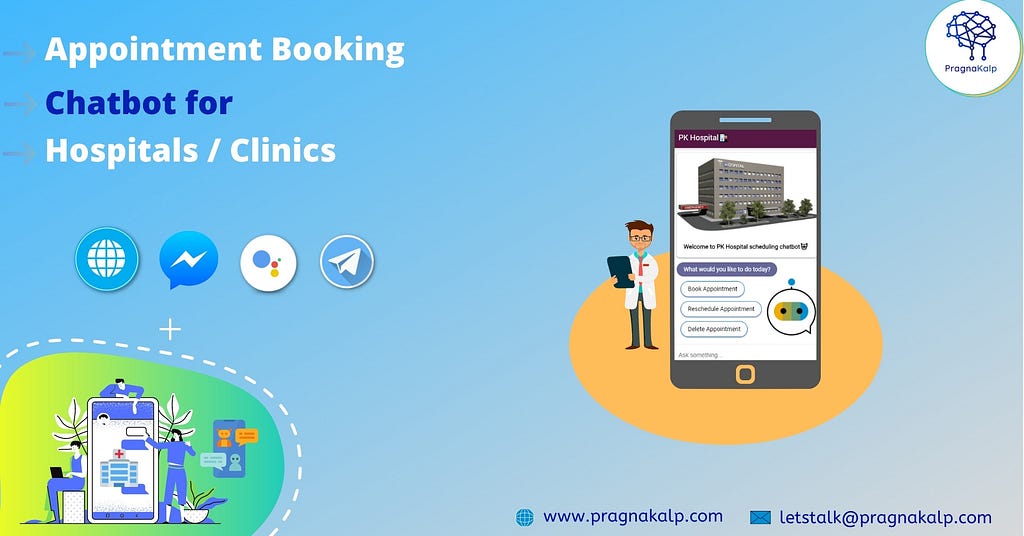
This pandemic has really taught us so many lessons. Among all the bad things that happened during these terrible times, one thing that proved to be a savior to mankind is the innovation and investment done in the Healthcare IT sector. After the contribution of our frontline workers, Healthcare IT has proved to be the biggest asset a country would ask for.
The last few years have been the most encouraging when it comes to innovation in the Healthcare IT sector. Be it telemedicine, Video consultation, Online pharmacies, or rather the entire digital ecosystem of Healthcare. Those innovations came to the rescue in the tough times and now it seems to become increasingly prevalent in different healthcare environments in order to increase the efficiency, quality of care delivered and help reduce costs.

Healthcare hasn’t been an early adopter when it comes to new automation technology, and the number will increase even more if you take patient experience tech into consideration. This low adaptation level may not necessarily be due to the resistance from the consumer/patient side. Rather, the scenario is quite different, patients may not like to call just for an appointment. Yet, this is the situation in so many cases.
Study shows, If given a chance, a considerable number of people between the ages of 30 and 45 do not want to call a hospital or navigate through confusing looking online appointment booking for doctor’s appointments of a new or followup visit. According to research. They prefer a medium/platform where they don’t need to wait in a queue and ask their query in their own language.
One such perhaps a small but the most pivotal technology is the chatbot. A chatbot is being widely accepted across industries and we are seeing more and more healthcare institutes have started using chatbots to effectively serve their patients.
A chatbot is essentially a computer program/software which simulates and processes human conversation (either written or spoken), enabling users to interact through multiple chat channels such as website, Facebook Messenger, Google Assistant, Telegram, etc. Chatbots are very popular to carry out some of the most common yet crucial tasks such as customer service, FAQs, Lead Generation, Appointment booking without any human intervention.
Looking at the scenario where many clinics or hospitals want to have a system where they can easily manage patients’ appointments more effectively, we have developed a Hospital Appointment booking chatbot, which will help clinics or hospitals to manage their appointments.
Trending Bot Articles:
2. Automated vs Live Chats: What will the Future of Customer Service Look Like?
4. Chatbot Vs. Intelligent Virtual Assistant — What’s the difference & Why Care?
Hospital Appointment booking chatbot
We have been developing Appointment booking chatbots for various businesses which can help them to manage their appointments and improve customer experience. We have already developed one generic appointment booking chatbot which can be helpful to various businesses. But to manage the specific requirements and intricacy a Healthcare industry brings, we have designed an Appointment booking chatbot that will help Hospitals, Doctors clinics, Dentists, Therapy centers, and anyone who wants to automate their Appointments Booking system.
Hospital Appointment booking chatbot can be integrated with multiple chat channels such as Website, Facebook Messenger, Telegram, and Google Assistant. We will integrate this chatbot on more chat channels such as SMS, Telephone (just as we did in PK Scheduler) in near future.
As far as the technological aspect of the chatbot is concerned, we have used the Dialogflow chatbot building platform to build this bot. Dialogflow brings its own strong NLP which makes the bot more intelligent. It also provides easy integration with multiple chat channels, which makes life easier for both developer and service provider at the time of integrating to their own preferred platform.
Choosing the right appointment management system is very important. Whatever the appointment management system you choose, it should be super easy to use for you or your employee. We have used Google Calendar to store the appointment. Google Calendar is super easy to use and accessible across the world. We have integrated this chatbot with Google Calendar, whenever a user booked an appointment it gets stored on google calendar.
Here are some of the key features and benefits offered by the Hospital Appointment booking chatbot.
- Schedule Appointment
- Reschedule Appointment
- Delete Appointment
- Answer FAQs
- Send Reminder
- Google Calendar Integration
- Multiple platform integration [Website, Facebook Messenger, Telegram, Google Assistant (subjected to approval)
- Available 24×7
- Improve patient engagement
- Decrease Human resource dependency
- Reduce operational cost
Access Website demo: Hospital Appointment Booking Chatbot
An Ideal Employee
If someone is managing a multispeciality hospital or someone is having their own clinic, managing appointments is the most crucial and quite annoying task. In the era where everyone is going for automation, having 24hrs dedicated to managing appointments hardly makes sense.
- When you compare expenses incurred in the form of the salary of an average individual (who is employed in managing appointments 24X7) with the cost of an Appointment booking chatbot, the difference becomes significant enough that a chatbot can be self-nominated.
- We, humans, tend to get influenced by the external environment, the performance may deteriorate in the bottleneck situation. Whereas a chatbot has the capability of performing SOPs in every situation.
- The current situation is such that we cannot afford the large gathering, systematic patient handling is the major task in the current situation. Appointment scheduling chatbot assists management by providing appointments to only permissible limits of patients.
- An appointment Booking chatbot is especially useful for Doctors who struggle to keep their business running on time, while also helping patients to schedule, reschedule or delete appointments.
A real-time feedback gathering system
Feedback gathering is the first step towards achieving greater customer/patient service. Chatbot makes the feedback gathering easy and exciting for the service provider as well as the customer/patient over filling out the feedback form.
Ease the burden on the Customer Executive
Customer service executives have always been under pressure to deliver accurate and reliable information to the maximum number of patients/customers in the most customer-friendly manner, but achieving the highest customer satisfaction is quite a challenging task. We humans can attend to one customer at a time. So as a result, many customers have to wait in a queue, either to get an answer to their query or to schedule their appointment. Having been able to handle multiple customers by providing answers to the user query, chatbot eases the burden from customer executives so that they can do more complex tasks.
Patient/Consumer’s perspective
We have mentioned the patient experience a couple of times in our article, but wonder what that means? I am sure many would have already guessed it right. Similar to Customer experience (as marketing people keep iterating) patient experience involves a whole lot of things. Besides the care availability of health plans, Doctors and Nurses expertise and support, and other health care facilities, several healthcare delivery aspects such as quick and easy appointment scheduling system, easy access to information, complaint handling, and resolving mechanism plays an important role in patient experience.
A chatbot can be an instrumental system when it comes to achieving a better patient experience.
A source of quick and reliable response:
- Hospital Appointment Chatbot allows patients to find out some of the key information quickly. Also, it helps customers to find out what are the available appointments on any given day.
- Getting the answer quickly without waiting in the line increases the patient experience.
Challenges
Chatbot being a programmed software has some limitations as well.
- They can only perform those tasks that the chatbot is trained for. The chatbot may not understand each human context.
- Functionality limitations may disappoint the user, as users tend to carry higher expectations.
- It becomes important to convey what users can achieve through the chatbot for a better user experience.
Even with some limitations, chatbots are flourishing in every sector be it a food ordering chatbot to customer service chatbot, chatbots are getting popular in carrying out some of the routing simple tasks so that businesses can focus on some of the more complex tasks.
Chatbot’s scope of applications in the Healthcare sector is huge. It’s a matter of time when a novel technology will soon become the new normal and an early adopter will enjoy the early mover advantage in terms of increased patient engagement, improved revenues, reduced operating costs, and, most importantly: seamless streamlined operations.
Do get in touch with us at letstalk@pragnakalp.com, if you have any feedback/questions regarding the Hospital Appointment booking chatbot. We would be happy to help you.
Don’t forget to give us your 👏 !



Appointment Booking Chatbot for Hospitals / Clinics was originally published in Chatbots Life on Medium, where people are continuing the conversation by highlighting and responding to this story.


